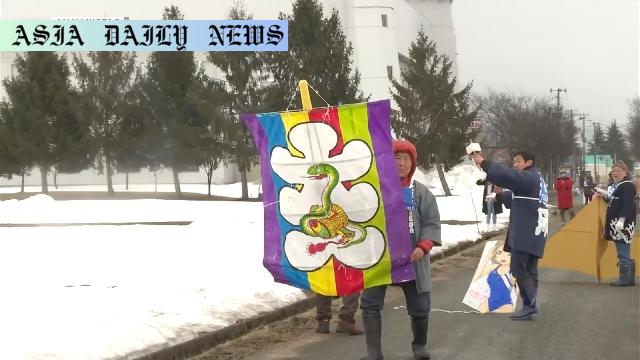Kite Festival: Experience Akita’s vibrant culture as people come together to welcome spring by flying traditional and vivid kites.
The Kite Festival in Akita marks the arrival of spring in northeastern Japan.
Traditional and handmade kites, such as the Managu kite, were showcased.
Despite rain, participants skillfully flew kites celebrating spring.
Visitors were impressed by Kabuki-inspired kite designs.

Marking Spring with a Traditional Art: Akita’s Kite Festival
The annual Kite Festival held in Yuzawa City, Akita Prefecture, is an illustrious celebration of Japan’s traditional art and the changing seasons. As the snow begins to melt, signaling the arrival of spring, people of all ages and backgrounds gather together with one goal in mind: to send beautifully crafted kites soaring into the sky. This year, over 130 participants joined the festive occasion, demonstrating creativity and skill while embracing an important cultural practice. The event not only symbolizes seasonal transition but also stands as a proud representation of regional tradition and collaboration, reflecting Japan’s rich cultural heritage.
A Canvas in the Sky: Unique Designs and Inspirations
Among the kites flown, some of the standout pieces included Yuzawa City’s local Managu kites, famed for their large and artistically expressive eyes. Others displayed colorful images of samurai warriors, embodying historical and artistic significance. The international crowd was particularly enthralled by kites featuring intricate Kabuki-inspired patterns, showcasing bold colors and detailed craftsmanship. These designs are more than mere decorations; they convey history, emotion, and the indomitable spirit of Japan’s artists and craftsmen. Such vibrant displays have drawn visitors not only from Japan but also from across the globe, cementing the festival as a must-visit attraction.
Facing Nature: The Spirit of Adaptation
Despite occasional rainfall, participants embraced the challenge with enthusiasm and resilience. Flying a kite, especially under tricky weather conditions, requires concentration, familiarity with the winds, and practiced technique—skills that have been passed down through generations. For many, it’s not just about performance but also reconnecting with nature. A participant from Miyagi Prefecture remarked on the refreshing and liberating feeling of watching a kite ascend into the skies, symbolizing happiness and release. These moments of joy are what distinguish this event as more than a festival—it becomes a heartfelt communion of people and their environment.
Bridging Local Culture and Global Communities
The Kite Festival has grown beyond just a regional event and has emerged as an international celebration of Japanese culture. Visitors from around the world witnessed the creativity demonstrated through the traditional and handmade kites, many of which tell stories of history, mythology, and artistry. One overseas attendee mentioned being captivated by the aesthetics of Kabuki-inspired kites, praising their beauty and cultural value. Festivals like these promote inclusivity, fostering an environment where shared appreciation transcends cultural boundaries. Additionally, the kite enthusiasts’ group works hard to preserve this centuries-old tradition while introducing it to global audiences, ensuring its legacy endures for future generations.
Pioneering a Future While Honoring the Past
Through creative expression and skilled craftsmanship, the Kite Festival is not only a celebration of spring but also a commitment to Japan’s cultural identity. It serves as a bridge between past and future, uniting younger generations with time-honored techniques and stories. Events like these inspire creativity, resilience, and cultural appreciation, making them integral to preserving both community spirit and historical understanding. As participants return year after year, the festival signals both personal growth and collective cultural progress.



Commentary
A Breathtaking Cultural Experience
The Kite Festival in Akita is truly a spectacular cultural event that offers a unique glimpse into traditional craftsmanship and community celebration. The flying of kites is such an evocative sight—an art form that speaks of freedom, resilience, and profound beauty. Events like these serve as a reminder of the deeper connection between nature and culture, bringing people together to honor history, heritage, and the natural rhythm of the seasons.
Kites as a Symbol of Unity and Creativity
What makes the festival so appealing is the diversity of kite designs, each telling its own story. From the striking Managu kite to vividly painted samurai warriors, each piece is an expression of artistic ingenuity. It’s interesting how something so simple—a kite—can showcase such profound history and emotion. Watching participants skillfully navigate their kites across the skies, undeterred by rain, is a testament to their passion and determination. These efforts inspire audiences to view kites not just as toys, but as moving canvases of creativity and cultural identity.
Global Appreciation for a Timeless Tradition
The global audience at the Akita Kite Festival highlights the universal appeal of this timeless tradition. Visitors photographing and appreciating Japanese designs remind us that cultural practices, no matter how localized, can resonate universally. This bridge between local authenticity and global admiration is key in fostering a shared understanding of art, history, and human ingenuity. The festival doesn’t just celebrate spring; it connects people from all walks of life through vibrant colors, compelling stories, and a love for the skies. What a remarkable way to welcome the change of seasons!